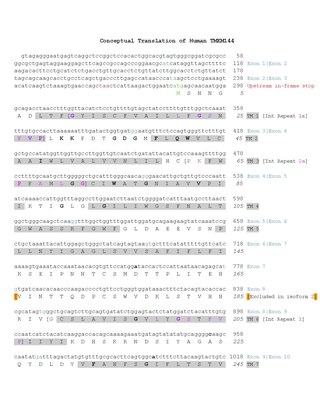Top Qs
Timeline
Chat
Perspective
TMEM144
Transmembrane Protein 144 From Wikipedia, the free encyclopedia
Remove ads
Transmembrane Protein 144 (TMEM144) is a protein in humans encoded by the TMEM144 gene.[1]

Remove ads
Gene
Transmembrane Protein 144 is located on the plus strand of chromosome 4 (4q32.1), spanning a total of 40,857 base pairs.[2] The TMEM144 gene transcribes a mRNA sequence 3,210 nucleotides in length and composed of 13 exons.[3]
Protein
Summarize
Perspective
There exist two isoforms of human Transmembrane Protein 144.[3] Isoform one consist of 345 amino acids with a total mass of 37.6 kDa.[1][4] This isoform has a theoretical isoelectric point of 6.63.[5] The second isoform is 169 amino acids long with a mass of 18.3 kDa.[3]

Expression
TMEM144 is over-expressed in adult brain tissue with low regional specificity.[6][7] TMEM144 appears enriched in oligodendrocytes[8][7] and immune cells, such as dendritic cells and monocytes.[9][7]
Cellular Localization
Precise cell localization has multiple predicted locations. Localization tools state TMEM144 is likely found in the plasma membrane, endoplasmic reticulum,[10] Lysosome/Vacuole, or Golgi apparatus.[11] However, an immunofluorescent staining of various human cell lines display localization to the mitochondria.[7]
Post Translational Modifications
There exists five predicted post translational modifications for TMEM144, including four sites of phosphorylation[12] and a sumoylation site.[13]

Interacting Proteins
Several proteins have been observed to be physically associated with TMEM144, including Transmembrane Protein 237, Homocysteine-Responsive Endoplasmic Reticulum-Resident Ubiquitin-Like Domain Member 2 Protein, Translocase of Inner Mitochondrial Membrane Domain-Containing Protein 1, Free Fatty Acid Receptor 2, Aquaporin 6, Serine Rich Single-Pass Membrane Protein 1, and Adrenoceptor Beta 2.[14][15]
Remove ads
Homology
Summarize
Perspective
Transmembrane Protein 144 arose approximately 694 million years ago in desert locust.[16] It can be found in both vertebrates and invertebrates.[16][17] It takes TMEM144 approximately 6.8 million years to make a 1% change to its amino acid sequence, indicating a moderately low rate of evolution.


Ortholog Table
Remove ads
Clinical Significance
Transmembrane Protein 144 is predicted to be a direct or indirect negative regulator of kisspeptin.[18] High expression of TMEM144 is prognostically favorable for patient with endometrial cancer.[19][7] Whereas in patients with pancreatic cancer, high expression of TMEM144 is associated with poor prognostic outcomes.[19][7]
References
Wikiwand - on
Seamless Wikipedia browsing. On steroids.
Remove ads
